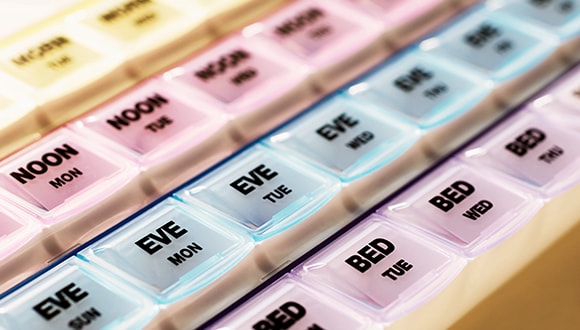Research improving medication use in Australia
A significant research program is helping to facilitate safe medication practices with Indigenous Australians.
Health Agenda magazine
July 2018
Taking medication safely can be difficult, especially when you take more than 1 drug a day – timing, remembering to take the medication and careful storage all play a part.
There’s an existing government service to help with this, and new research aims to help it reach more people.

What is a Home Medicines Review?
The Australian government introduced the Home Medicines Review (HMR) service in 2011 to reduce unsafe medication practices. An example could be poor communication between a doctor and patient leading to the patient taking the wrong dosage.
The service enlists specially-trained pharmacists to visit patients at home, assess their medication list, then work with their GP to develop a medication management plan.
Research to help vulnerable groups
While 75,900 reviews were delivered around Australia in 2016–17, “There are certain vulnerable groups in the community who don’t often get access to, but could really benefit from, HMR programs, such as elderly and isolated people, homeless people and some Aboriginal and Torres Strait Islander people,” says Dr Jannine Bailey, senior lecturer in rural health and research at Bathurst Rural Clinical School, part of Western Sydney University.
Thanks to an HCF Research Foundation grant, Dr Bailey is now leading the research arm of a program that will deliver some important, potentially life-changing medical services, as well as gather some much-needed data on Indigenous health.
The HCF Research Foundation grant has helped Dr Bailey to work with the team at the Orange Aboriginal Medical Service in NSW, to research the Home Medicines Review program for Indigenous people.
Indigenous health in rural areas
Indigenous Australians who live in remote areas experience significantly higher rates of cardiovascular disease, type 2 diabetes and chronic renal disease than the national average.
In the Medical Journal of Australia, clinical pharmacology researchers Dr Tilenka Thynne and Dr Genevieve Gabb said one factor was a lack of education and data on drug safety for Indigenous Australians.
They also underlined the diversity in the Aboriginal and Torres Strait Islander population. While we know that people around the world can have comparable responses to medications when they have racial and ethnic similarities, generalising across Indigenous groups could be inaccurate, as not all people will respond to drugs in the same way.
Studies have already revealed serious adverse effects among some Indigenous people to several medications, say the researchers, including the use of statins, which are prescribed to lower cholesterol.
What will the research do?
Dr Bailey’s research is surveying participants over a year, assessing the involvement of Aboriginal health workers and how HMRs can help people who have recently come out of hospital and those with chronic conditions. The team is assessing changes in a patient’s medications and health, and asking their thoughts on the service.
Orange Aboriginal Medical Service practice manager Amanda Kelly says the project includes HMRs for more than 100 patients who are taking 8 or more medications a day, 53 who take 7 a day, and 73 who take 5 medications a day.
“The HMR checks if patients actually need all the prescribed medication they’re taking – sometimes they’re prescribed something short-term and keep taking it, or they see a few different doctors.
Holistic health care
Dr Bailey says that many of the patients moved often or lived a long way from the clinic.
“We’ve got quite a transient population, quite a few clients who go back to country,” she says. “Perhaps they come to Orange only once a year or so. We look at scheduling an Aboriginal health check, dental check-up and HMR so that we can really cover everything off.”
Kelly points out that HMRs, when done in a supportive environment with an Aboriginal health worker, can lead to more holistic health care.
“HMRs can start by asking, ‘Why are you on these medications?’, then go on to say, ‘What else is going on with your life?’ Perhaps they need to do some exercise, or see other health professionals,” she says.
“We see real opportunities for using this project to close the gap in Indigenous health in Australia.”
Dr Bailey says that the Orange Aboriginal Medical Service is one of a number of programs around Australia delivering the reviews as part of their Indigenous health services – but this is the first time such a research project has taken place.
Related articles
HOW DOCTOR–PATIENT RELATIONSHIPS ARE CHANGING
Technology is changing the way patients interact with GPs in Australia. How does this affect you?
HOW TO AVOID MEDICATION INTERACTIONS
Prescribed medication is an exact science so it’s important not to mix it with anything that affects how it works.
LIVING WITH A CHRONIC DISEASE
Being diagnosed with a chronic illness can be an emotional and challenging time, but your mindset can have an impact on how you cope.
ADDICTIVE PRESCRIPTION DRUGS: UNDERSTAND THE RISKS
Get the facts on opiate and benzodiazepine misuse, and how to seek help.